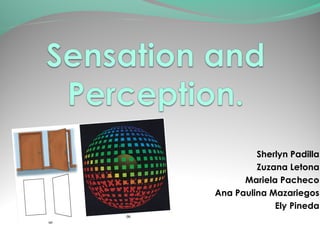Chapter 5 sensation and perception 1
•Transferir como PPT, PDF•
1 gostou•1,563 visualizações
The document discusses the differences between sensation and perception. Sensation is defined as the passive process of bringing external stimuli into the body and brain through the senses. Perception is the active process of selecting, organizing, and interpreting sensory information in the brain to give it meaning. Sensation involves sensory receptors detecting stimuli and transmitting neural signals, while perception occurs as the brain organizes and interprets those signals. The key differences are that sensation is passive intake of raw stimuli, while perception is the active interpretation and understanding of sensory information.
Denunciar
Compartilhar
Denunciar
Compartilhar

Recomendados
Mais conteúdo relacionado
Mais procurados
Mais procurados (20)
Semelhante a Chapter 5 sensation and perception 1
Semelhante a Chapter 5 sensation and perception 1 (20)
Present and explain each step in human perception process. To what e.pdf

Present and explain each step in human perception process. To what e.pdf
Mais de candyvdv
Mais de candyvdv (20)
Tt2 mind map teaching speaking and pronuntiation dmavd

Tt2 mind map teaching speaking and pronuntiation dmavd
Último
Mehran University Newsletter is a Quarterly Publication from Public Relations OfficeMehran University Newsletter Vol-X, Issue-I, 2024

Mehran University Newsletter Vol-X, Issue-I, 2024Mehran University of Engineering & Technology, Jamshoro
God is a creative God Gen 1:1. All that He created was “good”, could also be translated “beautiful”. God created man in His own image Gen 1:27. Maths helps us discover the beauty that God has created in His world and, in turn, create beautiful designs to serve and enrich the lives of others.
Explore beautiful and ugly buildings. Mathematics helps us create beautiful d...

Explore beautiful and ugly buildings. Mathematics helps us create beautiful d...christianmathematics
Último (20)
Z Score,T Score, Percential Rank and Box Plot Graph

Z Score,T Score, Percential Rank and Box Plot Graph
Presentation by Andreas Schleicher Tackling the School Absenteeism Crisis 30 ...

Presentation by Andreas Schleicher Tackling the School Absenteeism Crisis 30 ...
Measures of Central Tendency: Mean, Median and Mode

Measures of Central Tendency: Mean, Median and Mode
General Principles of Intellectual Property: Concepts of Intellectual Proper...

General Principles of Intellectual Property: Concepts of Intellectual Proper...
On National Teacher Day, meet the 2024-25 Kenan Fellows

On National Teacher Day, meet the 2024-25 Kenan Fellows
Seal of Good Local Governance (SGLG) 2024Final.pptx

Seal of Good Local Governance (SGLG) 2024Final.pptx
This PowerPoint helps students to consider the concept of infinity.

This PowerPoint helps students to consider the concept of infinity.
Explore beautiful and ugly buildings. Mathematics helps us create beautiful d...

Explore beautiful and ugly buildings. Mathematics helps us create beautiful d...
Beyond the EU: DORA and NIS 2 Directive's Global Impact

Beyond the EU: DORA and NIS 2 Directive's Global Impact
Ecological Succession. ( ECOSYSTEM, B. Pharmacy, 1st Year, Sem-II, Environmen...

Ecological Succession. ( ECOSYSTEM, B. Pharmacy, 1st Year, Sem-II, Environmen...
Chapter 5 sensation and perception 1
- 1. Sherlyn Padilla Zuzana Letona Mariela Pacheco Ana Paulina Mazariegos Ely Pineda
- 2. When we smell a fragrant flower, are we experimenting sensation or perception? In everyday language, the terms "sensation" and "perception' are often used interchangeably. However, as you will see, they are very different complementary processes.
- 3. Sensations can be defined as the passive process of bringing information from the outside world into the body and into the brain. The process is passive because we do not have to be consciously engaging in a "sensing" process.
- 4. Sensation doesn't automatically occur; sensory processes must first transform stimulation into neural messages before any other processing is formed. This process of transferring energy is termed transduction. Stimuli detectors are important because one of their abilities is to alert us to changes. They also hold authority in sensory adaptation; the absolute threshold, the terminal threshold, and the difference threshold.
- 5. ABSOLUTE THRESHOLD: is the lowest level that a person will feel sensation. DIFFERENTIAL THRESHOLD: is the minimal difference that a person can detect between two stimuli. TERMINAL THRESHOLD: the intensity of the stimulus is so high above the absolute threshold that it causes the person pain. The intensity of the stimulus is high enough that the sensory receptors and neurons maybe damaged.
- 6. Perception can be defined as the active process of selecting, organizing, and interpreting the information brought to the brain by the senses. Perception is how one "receives" this feeling or thought, and gives meaning to it through memories and emotions.
- 7. 1) Sensation occurs: a) sensory organs absorb energy from a physical stimulus in the environment. b) sensory receptors convert this energy into neural impulses and send them to the brain. 2) Perception follows: a) the brain organizes the information and translates it into something meaningful.
- 8. Sensation: The sense organs register the stimulus – with it's physical properties, "decode" it, and transform it into a neural signal that is then transmitted to the brain. Perception: In the brain, the neural signal is organized and interpreted. Perception involves "making sense" of our sensations.
- 9. https://www.youtube.com/watch? v=0SErqVGcAR0 https://www.youtube.com/watch? v=IDQcFlPqaFs http://education-portal. com/academy/lesson/intro-to-sensation-and- perception.html#lesson
- 10. https://www.youtube.com/watch? v=0SErqVGcAR0 https://www.youtube.com/watch? v=IDQcFlPqaFs http://education-portal. com/academy/lesson/intro-to-sensation-and- perception.html#lesson